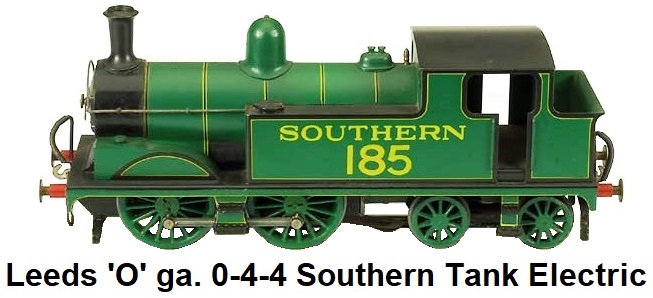 The Leeds Model Company was founded in 1912 by Reginald 'Rex' Frederick Stedman (1893-1959) in Leeds, England. Initially Stedman produced and sold
completely hand-built models as during World War I the development of any machine tooling for mass creation of hobby products had been restricted.
The company started by offering a range of die cast parts for signals, rolling stock and locomotives, including an 'O' gauge
4-coupled clockwork mechanism. From these modest beginnings the company
grew rapidly after 1919. With the help and financing of wealthy model railway enthusiast G. P. Keen
the company moved from custom building into mass production of a first series of standardized scale model tank locomotives. The first printed
book style catalogues were issued in 1920. LMC quickly became
the third-largest model railway producer in Great Britain after Hornby and Bassett-Lowke
in the years between World Wars I and II. Company policy was to produce toy trains that were not pure scale models but that were affordable
and accurate 'O' gauge operating models. Rex Stedman's designs offered a maximum range of products with minimum cost to provide
his customers a choice as wide as possible with inexpensive prices. Leeds also produced rolling stock, railway accessories and
track with wooden sleepers. The early handmade high quality cars developed prior to World War I remained available until after
World War II, in both 'O' gauge and gauge 1. Locomotives were produced in clockwork powered and 3-rail electric versions.
The trains manufactured by Leeds were of British prototypes. During its years of operation the company was housed at various
locations in Leeds, England, including Jack Lane, Hunslet and Potterdale Mills, Dewsbury Road.
The Leeds Model Company was founded in 1912 by Reginald 'Rex' Frederick Stedman (1893-1959) in Leeds, England. Initially Stedman produced and sold
completely hand-built models as during World War I the development of any machine tooling for mass creation of hobby products had been restricted.
The company started by offering a range of die cast parts for signals, rolling stock and locomotives, including an 'O' gauge
4-coupled clockwork mechanism. From these modest beginnings the company
grew rapidly after 1919. With the help and financing of wealthy model railway enthusiast G. P. Keen
the company moved from custom building into mass production of a first series of standardized scale model tank locomotives. The first printed
book style catalogues were issued in 1920. LMC quickly became
the third-largest model railway producer in Great Britain after Hornby and Bassett-Lowke
in the years between World Wars I and II. Company policy was to produce toy trains that were not pure scale models but that were affordable
and accurate 'O' gauge operating models. Rex Stedman's designs offered a maximum range of products with minimum cost to provide
his customers a choice as wide as possible with inexpensive prices. Leeds also produced rolling stock, railway accessories and
track with wooden sleepers. The early handmade high quality cars developed prior to World War I remained available until after
World War II, in both 'O' gauge and gauge 1. Locomotives were produced in clockwork powered and 3-rail electric versions.
The trains manufactured by Leeds were of British prototypes. During its years of operation the company was housed at various
locations in Leeds, England, including Jack Lane, Hunslet and Potterdale Mills, Dewsbury Road.

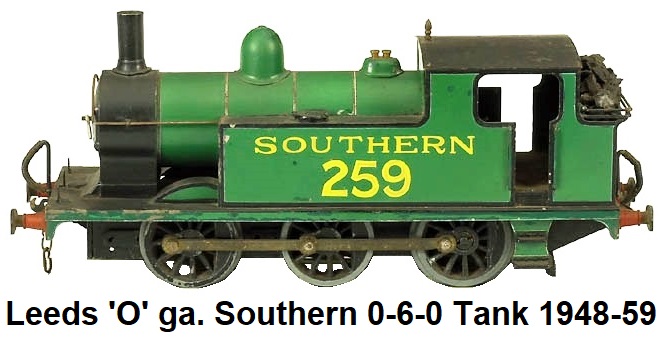
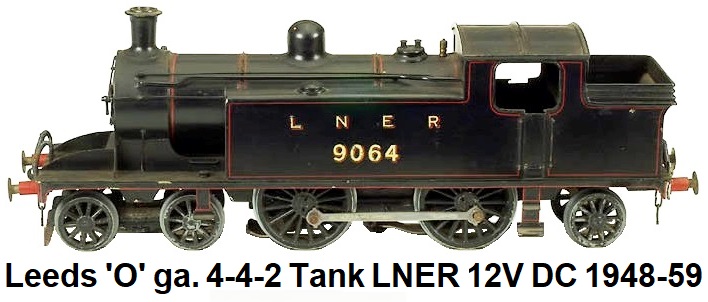
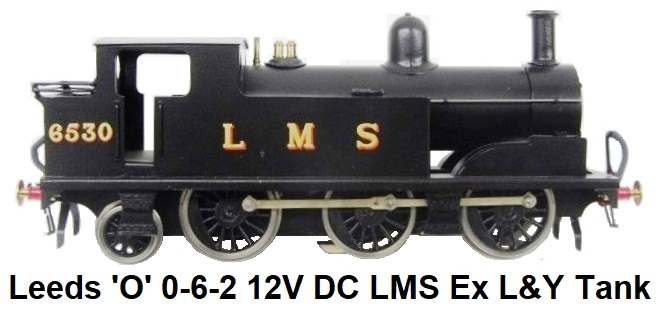
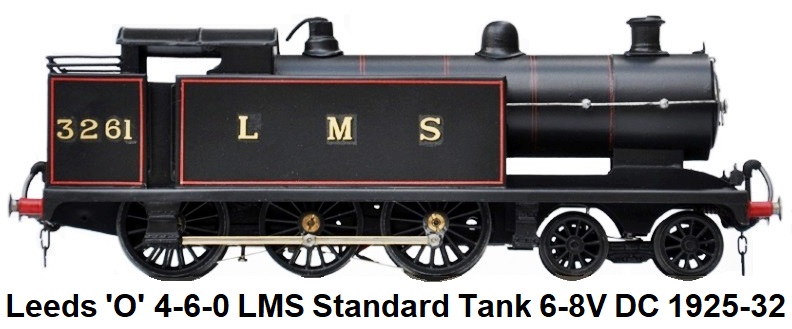
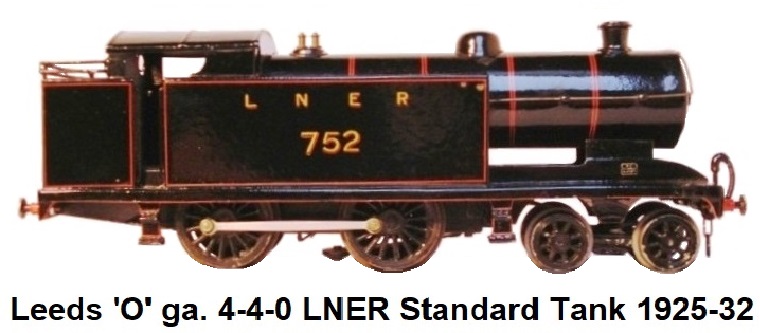 The first series Standard Tank Locomotive was made from 1920 until 1932. The goal of Rex Stedman was to produce a near scale product
from an actual known prototype. The rest of his approach was to make the widest possible range at minimum costs. He achieved this by re-using
most of the standard parts from the LMC range to build a wide variety of tank locomotives. Simply by changing a wheel arrangement, chimney,
safety valve or dome, Stedman was able to model the various engines representing all the railway companies in England.
Initially the 4-4-0 Tank loco was made. In subsequent catalogues another four versions of the first series tank locomotives
were offered as a 4-4-2 Tank, a 4-6-0 Tank, an 0-4-4 Tank and an 0-6-2 Tank.
Along with the Standard tank other models such as the ex Great Central Railway 4-4-0 ‘Butler Henderson’ (Improved Director Class),
and 4-6-0 ‘Sir Sam Fay’ tender locomotives were introduced. Two locomotives, a Great Western Churchward 4-4-0 County Class and
Pickersgill Class 72 Caledonian 4-4-0 were produced for Bassett-Lowke in 1922. As was LMC's pratice, the parts
and tooling for these locomotives were later used to manufacture the Leeds Model Company Great Western Railway Mogul and the
Pickersgill 0-6-0 goods locomotives. Other models supplied at this time were a
London Midland & Scotish Railway Sir Gilbert Claughton, a London & North Eastern Railway (Ex Great Northern Railway)
Atlantic, LNER 4-6-2 classes A1 and A2, and a Urie 4-6-2T. One of the most distinctive of the freelance models was the 0-4-0
Saddle Tank Locomotive. This became the longest lived model in the LMC range, being available for over 40 years starting from
the early 1920's.
The first series Standard Tank Locomotive was made from 1920 until 1932. The goal of Rex Stedman was to produce a near scale product
from an actual known prototype. The rest of his approach was to make the widest possible range at minimum costs. He achieved this by re-using
most of the standard parts from the LMC range to build a wide variety of tank locomotives. Simply by changing a wheel arrangement, chimney,
safety valve or dome, Stedman was able to model the various engines representing all the railway companies in England.
Initially the 4-4-0 Tank loco was made. In subsequent catalogues another four versions of the first series tank locomotives
were offered as a 4-4-2 Tank, a 4-6-0 Tank, an 0-4-4 Tank and an 0-6-2 Tank.
Along with the Standard tank other models such as the ex Great Central Railway 4-4-0 ‘Butler Henderson’ (Improved Director Class),
and 4-6-0 ‘Sir Sam Fay’ tender locomotives were introduced. Two locomotives, a Great Western Churchward 4-4-0 County Class and
Pickersgill Class 72 Caledonian 4-4-0 were produced for Bassett-Lowke in 1922. As was LMC's pratice, the parts
and tooling for these locomotives were later used to manufacture the Leeds Model Company Great Western Railway Mogul and the
Pickersgill 0-6-0 goods locomotives. Other models supplied at this time were a
London Midland & Scotish Railway Sir Gilbert Claughton, a London & North Eastern Railway (Ex Great Northern Railway)
Atlantic, LNER 4-6-2 classes A1 and A2, and a Urie 4-6-2T. One of the most distinctive of the freelance models was the 0-4-0
Saddle Tank Locomotive. This became the longest lived model in the LMC range, being available for over 40 years starting from
the early 1920's.
 Early in 1920 in an effort to reduce production costs, and while continuing to supply hand built wooden stock,
Stedman developed a pre-grouping range of wagons and coaches using high quality embossed paper on standardized
pine timber bodies. By 1923 the process moved to wagons covered with litho printed paper and varnished with a matt finish.
The wooden corners were lock jointed and the floors were grooved to provide greater strength.
On covered vehicles, the roofs were made of metal and were fitted securely into grooves in the top of the body work.
The 4-wheel wagons used white metal castings for the axle boxes and were fitted with unbreakable axle guards.
8-wheel wagons were fitted with tinplate bogies. Wheels were made of a metal alloy called 'Newalloy'. These wagons
were decorated with non-locking buffers, and scale 3-link couplings with fitted springs. All wood goods stock was finished
with matt celluloid varnish. Coaching stock was finished with a glossy celluloid varnish. As well as being cheaper to produce,
the paper decals meant that Leeds could offer customers the chance to give their existing wooden rolling stock a new identity
just by buying and applying a fresh set of decals.
One of the most well-known LMC products were the passenger coaches and wagons made with wooden bodies
that were covered with the lithographed paper. The coaches were available between 1923 and 1966 when production finally
ceased. Towards the end, these coaches were sold only in kit form. The coach shown here belongs to that series.
Early in 1920 in an effort to reduce production costs, and while continuing to supply hand built wooden stock,
Stedman developed a pre-grouping range of wagons and coaches using high quality embossed paper on standardized
pine timber bodies. By 1923 the process moved to wagons covered with litho printed paper and varnished with a matt finish.
The wooden corners were lock jointed and the floors were grooved to provide greater strength.
On covered vehicles, the roofs were made of metal and were fitted securely into grooves in the top of the body work.
The 4-wheel wagons used white metal castings for the axle boxes and were fitted with unbreakable axle guards.
8-wheel wagons were fitted with tinplate bogies. Wheels were made of a metal alloy called 'Newalloy'. These wagons
were decorated with non-locking buffers, and scale 3-link couplings with fitted springs. All wood goods stock was finished
with matt celluloid varnish. Coaching stock was finished with a glossy celluloid varnish. As well as being cheaper to produce,
the paper decals meant that Leeds could offer customers the chance to give their existing wooden rolling stock a new identity
just by buying and applying a fresh set of decals.
One of the most well-known LMC products were the passenger coaches and wagons made with wooden bodies
that were covered with the lithographed paper. The coaches were available between 1923 and 1966 when production finally
ceased. Towards the end, these coaches were sold only in kit form. The coach shown here belongs to that series.
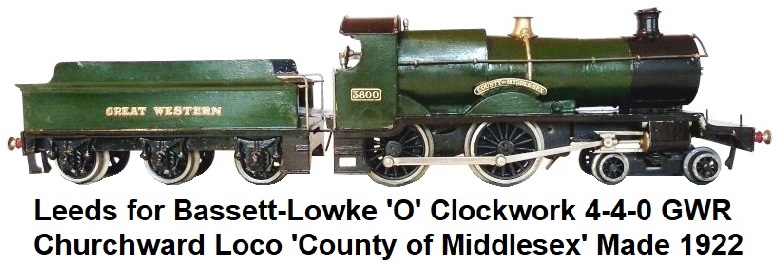 G. P. Keen backed out of the LMC in 1924, making way for Hugh Leader of the Bristol Model Company. Significantly with this
‘West Country’ influence, the first Great Western Railway locomotives, a Star and Castle made their appearance in the
catalogue. 1925 saw the introduction of a 4-coupled 8 volt electric motor. These motors remained in use through 1935.
In 1925 LMC was formally merged with Bristol Model Co. As a consequence Stedman was no longer head of the enterprise but
chief constructor only. In 1927 Stedman created its first private owner wagons. The initial wagon was in response
to a private order from a Leeds based coal exporting company associated with the Whiting family called Hargreaves Coal.
G. P. Keen backed out of the LMC in 1924, making way for Hugh Leader of the Bristol Model Company. Significantly with this
‘West Country’ influence, the first Great Western Railway locomotives, a Star and Castle made their appearance in the
catalogue. 1925 saw the introduction of a 4-coupled 8 volt electric motor. These motors remained in use through 1935.
In 1925 LMC was formally merged with Bristol Model Co. As a consequence Stedman was no longer head of the enterprise but
chief constructor only. In 1927 Stedman created its first private owner wagons. The initial wagon was in response
to a private order from a Leeds based coal exporting company associated with the Whiting family called Hargreaves Coal.
 Stedman and Leader were uneasy partners in the business however, and
Rex Stedman left LMC in 1928 to found a new company under the name of R.F. Stedman & Co. In that same year Leeds
experienced financial troubles, as Stedman had invested large sums in creating models from the British pre-grouping era, but from 1923 on,
customers demanded models representing the Big Four – which Leeds could not provide. The Big Four was the name used to describe
the four largest railway companies in the United Kingdom in the period 1923–47. The Big Four were the Great Western Railway (GWR),
London, Midland and Scottish Railway (LMS), London and North Eastern Railway (LNER), and the Southern Railway (SR).
These companies were formed as a result of the Railways Act of 1921, in a process known as 'The Grouping' (of the railways), which went
into effect on January 1, 1923.
Stedman and Leader were uneasy partners in the business however, and
Rex Stedman left LMC in 1928 to found a new company under the name of R.F. Stedman & Co. In that same year Leeds
experienced financial troubles, as Stedman had invested large sums in creating models from the British pre-grouping era, but from 1923 on,
customers demanded models representing the Big Four – which Leeds could not provide. The Big Four was the name used to describe
the four largest railway companies in the United Kingdom in the period 1923–47. The Big Four were the Great Western Railway (GWR),
London, Midland and Scottish Railway (LMS), London and North Eastern Railway (LNER), and the Southern Railway (SR).
These companies were formed as a result of the Railways Act of 1921, in a process known as 'The Grouping' (of the railways), which went
into effect on January 1, 1923.
 1935 saw the introduction of the Leeds 6-coupled 6-8 volt DC electric motor.
In the late 1930's goods wagons and coaches with bodies made from
molded bakelite were produced. Leeds was the first producer in Great Britain to utilize that material. An unexpected side effect
of the then-new Bakelite plastic material was realistic sound transmission properties brought about as a result of the weight and shape
of the wagons. These models turned out to have an uncanny ability to sound like real railway carriages when they crossed a model
railway layout's point. As a result, these Leeds models have the slightly odd distinction of getting rave reviews from enthusiasts
for the noise they made. 5 versions of the mineral wagons and 6 versions of freight vans were supplied in 1937. By adding details
as ventilators, brake pipes and transfers to the freight vans, including variation of the running numbers supplied, LMC again tried
to make the widest possible range at minimum costs. The pre-war versions of the freight and mineral wagons were made in colored
Bakelite. After the war all bodies were black and the livery was painted on.
1935 saw the introduction of the Leeds 6-coupled 6-8 volt DC electric motor.
In the late 1930's goods wagons and coaches with bodies made from
molded bakelite were produced. Leeds was the first producer in Great Britain to utilize that material. An unexpected side effect
of the then-new Bakelite plastic material was realistic sound transmission properties brought about as a result of the weight and shape
of the wagons. These models turned out to have an uncanny ability to sound like real railway carriages when they crossed a model
railway layout's point. As a result, these Leeds models have the slightly odd distinction of getting rave reviews from enthusiasts
for the noise they made. 5 versions of the mineral wagons and 6 versions of freight vans were supplied in 1937. By adding details
as ventilators, brake pipes and transfers to the freight vans, including variation of the running numbers supplied, LMC again tried
to make the widest possible range at minimum costs. The pre-war versions of the freight and mineral wagons were made in colored
Bakelite. After the war all bodies were black and the livery was painted on.


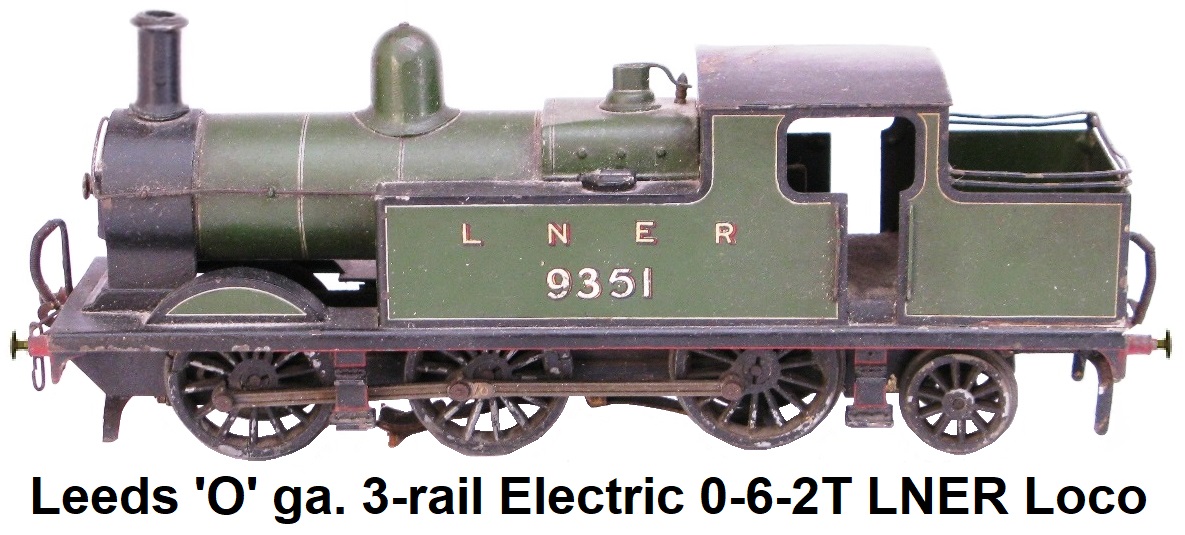 When Rex Stedman left LMC, he used financing from R.S. Moore, and took over the assets and goodwill of the former Leeds Model Company.
For four years Stedman ran the company under his own name as R.F. Stedman and Co. Ltd. So Stedman was able to buy
back his former enterprise including name rights. He widened the range to offer models of the Big Four. He also continued
the issue of the popular private owner coal wagons. 8 new designs were created for general release starting in 1928. But in 1931 he
resigned from directorship, this time for good. His fellow directors, Moore and G.M. Simpson, took the company back under
the former LMC style in 1932, but continued to develop Stedman’s concepts and
designs to update and further extend the product range. The name reverted to Leeds Model Company at this time. The Sentinel Cammell steam
railcar ‘Nettle’ and the Brighton Belle Pullman rake of five coaches were produced, along with additions to the private owner wagon range and
new ‘button logo’ lithos for the GW coach range.
When Rex Stedman left LMC, he used financing from R.S. Moore, and took over the assets and goodwill of the former Leeds Model Company.
For four years Stedman ran the company under his own name as R.F. Stedman and Co. Ltd. So Stedman was able to buy
back his former enterprise including name rights. He widened the range to offer models of the Big Four. He also continued
the issue of the popular private owner coal wagons. 8 new designs were created for general release starting in 1928. But in 1931 he
resigned from directorship, this time for good. His fellow directors, Moore and G.M. Simpson, took the company back under
the former LMC style in 1932, but continued to develop Stedman’s concepts and
designs to update and further extend the product range. The name reverted to Leeds Model Company at this time. The Sentinel Cammell steam
railcar ‘Nettle’ and the Brighton Belle Pullman rake of five coaches were produced, along with additions to the private owner wagon range and
new ‘button logo’ lithos for the GW coach range.


 In 1935 the second series of 6 standard tank locomotives came on the market. Some of the range,
albeit in kit form, survived until the company finally ceased trading in 1967. These locos were nearer to scale than
the first series. They are some of the products for which LMC is best remembered. As usual with LMC, LNER was well
represented with a GCR Class G5 0-4-4 Tank, a GER Class F4 2-4-2 Tank and a
GCR Class N5 0-6-2 Tank. LMS was catered for by a L&Y 0-6-2 Tank and a L&Y 2-4-2 Tank, while Southern enthusiasts
had a LSWR Adams Class T1 0-4-4 Tank. These six quite distinct models, of which the most commonly seen today are the
LMS (Ex L&Y) 2-4-2T and the LNER (Ex GC) 0-6-2T, were economically engineered to come from a single set of tooling and dies.
In 1935 the second series of 6 standard tank locomotives came on the market. Some of the range,
albeit in kit form, survived until the company finally ceased trading in 1967. These locos were nearer to scale than
the first series. They are some of the products for which LMC is best remembered. As usual with LMC, LNER was well
represented with a GCR Class G5 0-4-4 Tank, a GER Class F4 2-4-2 Tank and a
GCR Class N5 0-6-2 Tank. LMS was catered for by a L&Y 0-6-2 Tank and a L&Y 2-4-2 Tank, while Southern enthusiasts
had a LSWR Adams Class T1 0-4-4 Tank. These six quite distinct models, of which the most commonly seen today are the
LMS (Ex L&Y) 2-4-2T and the LNER (Ex GC) 0-6-2T, were economically engineered to come from a single set of tooling and dies.
 Following the end of World War II, Leeds began supplying retailers, and no longer sold direct
to consumers or hobbyists. The primary focus of production was now on parts for kits and scratch building.
At its peak, the inventory of the Leeds Model Company production numbered a staggering 4,000 parts. In 1946
the Leeds motor was rewired for 12 volt DC operation. In 1949 Leeds introduced
their first ever boxed 'O' gauge train set. The freight set featured an 0-4-0 Saddle Tank loco, two goods vans and an open wagon,
all in Bakelite, and 3-rail track loop. Passenger train sets were also available in the big four and British Rail liveries.
These sets contained the 4-4-0 tender locomotive and three Bakelite coaches.
Following the end of World War II, Leeds began supplying retailers, and no longer sold direct
to consumers or hobbyists. The primary focus of production was now on parts for kits and scratch building.
At its peak, the inventory of the Leeds Model Company production numbered a staggering 4,000 parts. In 1946
the Leeds motor was rewired for 12 volt DC operation. In 1949 Leeds introduced
their first ever boxed 'O' gauge train set. The freight set featured an 0-4-0 Saddle Tank loco, two goods vans and an open wagon,
all in Bakelite, and 3-rail track loop. Passenger train sets were also available in the big four and British Rail liveries.
These sets contained the 4-4-0 tender locomotive and three Bakelite coaches.
 After World War II Leeds was among the first to produce locomotives with working smoke generators. The smoke was generated
in a die cast box fitted in the loco cabs. The box had an inlet and a outlet port. The inlet connected to a cylinder fitted
to the mechanism, the outlet port was connected to the loco chimney. The puffing action was facilitated via an eccentric
crank and rod mechanism mounted to the drive axle. Locos were supplied with a box of a dozen bottles of smoke oil,
a funnel and a glass extension. A new model, the 7th in the series of standard tank locos, was introduced. This model was close
to a Jinty 0-6-0 tank. Shortages of materials forced Leeds to change several goods brake van models from the original
wood construction to utilize tinplate instead. They were still hand built however.
After World War II Leeds was among the first to produce locomotives with working smoke generators. The smoke was generated
in a die cast box fitted in the loco cabs. The box had an inlet and a outlet port. The inlet connected to a cylinder fitted
to the mechanism, the outlet port was connected to the loco chimney. The puffing action was facilitated via an eccentric
crank and rod mechanism mounted to the drive axle. Locos were supplied with a box of a dozen bottles of smoke oil,
a funnel and a glass extension. A new model, the 7th in the series of standard tank locos, was introduced. This model was close
to a Jinty 0-6-0 tank. Shortages of materials forced Leeds to change several goods brake van models from the original
wood construction to utilize tinplate instead. They were still hand built however.
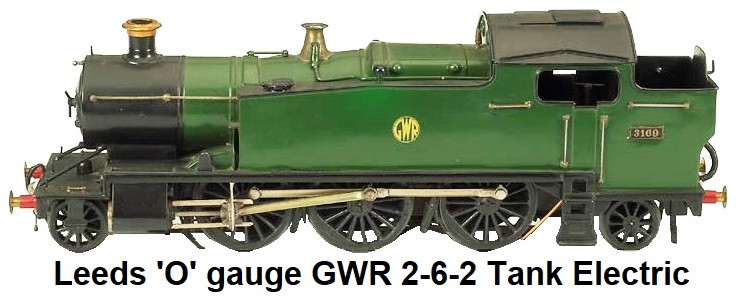 With the end of World War II 'O' gauge had a strong but
short boom, probably caused by the desire to catch up with what was missed during the war. But from about 1950 on 'OO'
gauge became more and more popular and nearly completely superseded 'O' gauge in the UK market. Enterprises dealing with
'O' gauge only hardly had any chances of success. Nevertheless the company moved boldly to introduce several new
locomotives including standard 4-4-0 tender locos and the seventh series 2 standard tank configured as a short 0-6-0.
Tender models were designed for maximum cost reduction without undue sacrifice of realistic appearance. They were freely
adapted to suit any of the big four companies and, later, BR prototypes. Train sets, both goods and passenger, were
offered from the early 1950’s. Also from 1950, outworked locomotives, made by professional modellers, including an
LMS Jubilee, GW Hawksworth County, GW 57XX Pannier and Prairie tanks, and even an LMS Princess, were also
featured in the product range. These and all other ready to run locomotives ceased to be available after 1959.
In 1954 LMC was renamed Ellemsee Accessories and moved to Wheaton Ave., Halton, Leeds. Ellemsee survived until
1966 but the range of products became smaller and smaller until nothing much was left.
The product range was then more or less confined to spare parts and kits. The company ceased operations and went
into liquidation in 1967. Rex Stedman had passed away six years before.
With the end of World War II 'O' gauge had a strong but
short boom, probably caused by the desire to catch up with what was missed during the war. But from about 1950 on 'OO'
gauge became more and more popular and nearly completely superseded 'O' gauge in the UK market. Enterprises dealing with
'O' gauge only hardly had any chances of success. Nevertheless the company moved boldly to introduce several new
locomotives including standard 4-4-0 tender locos and the seventh series 2 standard tank configured as a short 0-6-0.
Tender models were designed for maximum cost reduction without undue sacrifice of realistic appearance. They were freely
adapted to suit any of the big four companies and, later, BR prototypes. Train sets, both goods and passenger, were
offered from the early 1950’s. Also from 1950, outworked locomotives, made by professional modellers, including an
LMS Jubilee, GW Hawksworth County, GW 57XX Pannier and Prairie tanks, and even an LMS Princess, were also
featured in the product range. These and all other ready to run locomotives ceased to be available after 1959.
In 1954 LMC was renamed Ellemsee Accessories and moved to Wheaton Ave., Halton, Leeds. Ellemsee survived until
1966 but the range of products became smaller and smaller until nothing much was left.
The product range was then more or less confined to spare parts and kits. The company ceased operations and went
into liquidation in 1967. Rex Stedman had passed away six years before.
Leeds Model Company Goods Wagons
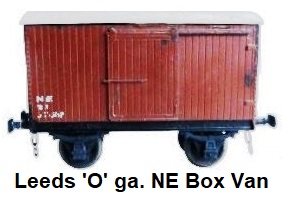

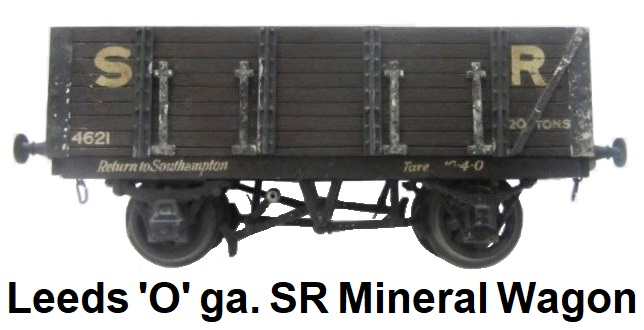
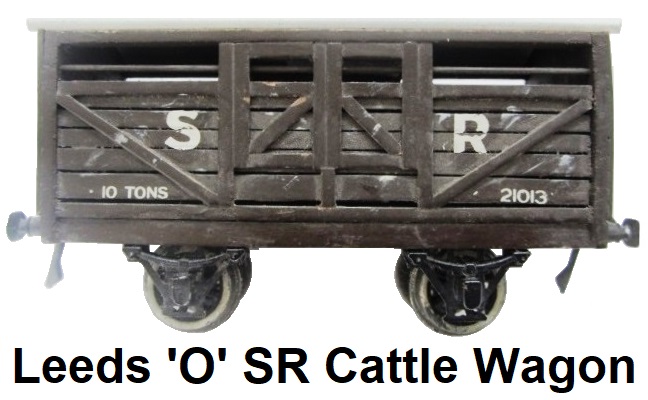
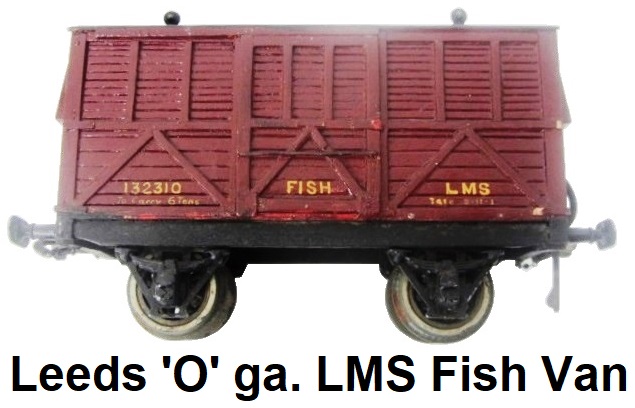
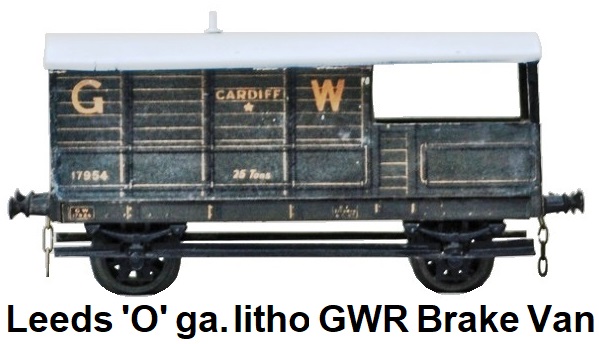

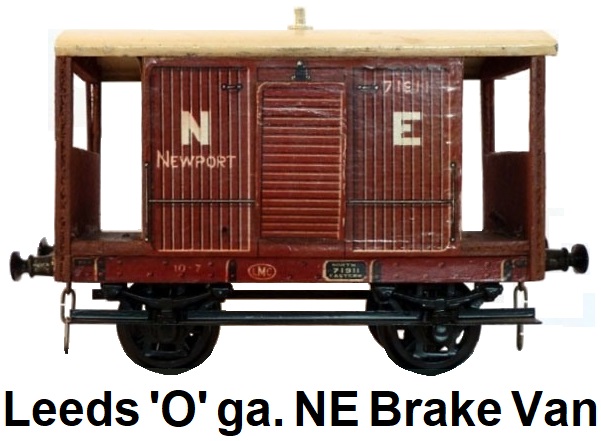
Leeds Model Company Private Owner Goods Wagons
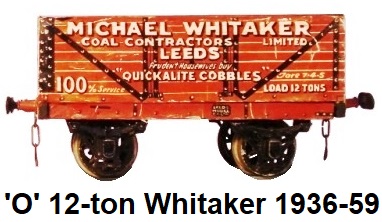
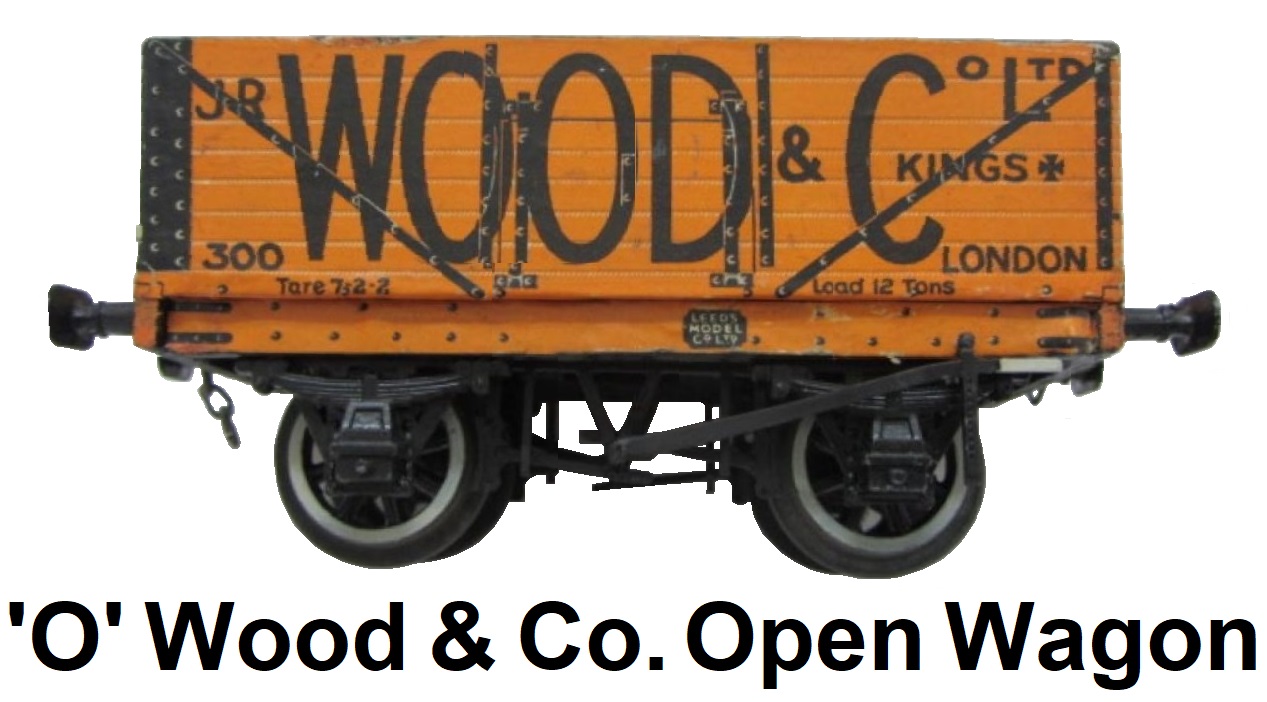
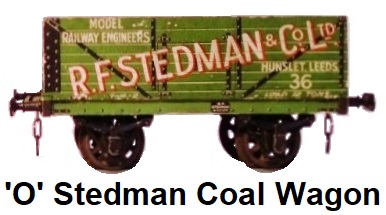
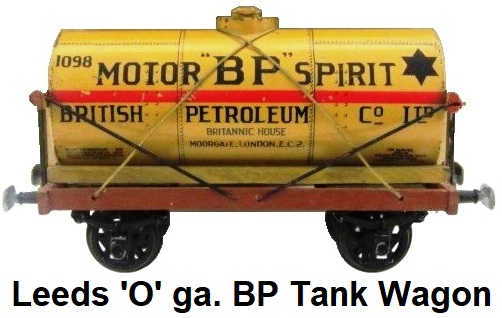


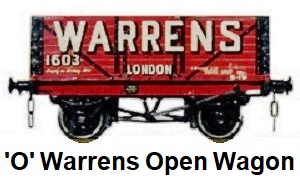
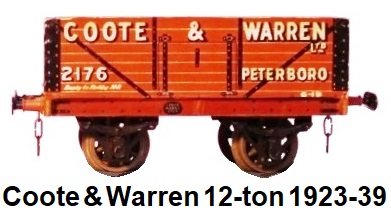
Prior to Rex Stedman leaving the Leeds Model Company in 1930, he designed the 'O' gauge model of the LNER Sentinel-Cammell
steam railcar. This powered passenger railcar was produced from 1935 until the 1950's. The body of the model was constructed of wood and
fitted with paper lithography.
 The Sentinel-Cammell railcar model's power bogie used a standard 12 volt DC electric motor. This same motor bogie
was also used to power the Leed's model of the Brighton Belle. After 1953, Ellemsee issued a kit version of the LNER Sentinel-Cammell
steam railcar. The prototype for this model was built by Sentinel Waggon Works of Shrewsbury in 1923 for the narrow gauge Jersey
Railways & Tramways Ltd. The full sized railcar used coachwork constructed by Cammell Laird & Co. of Nottingham. At this time, the LNER was
seeking more economic alternatives to steam trains, petrol rail buses and auto car railroad equipment with better passenger capacity. They
eventually acquired 80 of these steam powered railcars produced in a long series of relatively small batches.
The Sentinel-Cammell railcar model's power bogie used a standard 12 volt DC electric motor. This same motor bogie
was also used to power the Leed's model of the Brighton Belle. After 1953, Ellemsee issued a kit version of the LNER Sentinel-Cammell
steam railcar. The prototype for this model was built by Sentinel Waggon Works of Shrewsbury in 1923 for the narrow gauge Jersey
Railways & Tramways Ltd. The full sized railcar used coachwork constructed by Cammell Laird & Co. of Nottingham. At this time, the LNER was
seeking more economic alternatives to steam trains, petrol rail buses and auto car railroad equipment with better passenger capacity. They
eventually acquired 80 of these steam powered railcars produced in a long series of relatively small batches.
 Leeds Model Company is best known for their large range of locomotives, from freelance to exhibition-class specimens, as
well as the early coaches and wagons made from wood with applied paper lithography. They are also remembered for their later molded Bakelite
coaches, wagons and vans that were introduced in the late 1930’s and were an immediate success. The post World War II years were difficult
for all model companies, not just Leeds with its focus on the 'O' gauge. Leeds Model Company trains are considered rare and difficult to find
in good condition by collectors. Due to poor cleaning and priming of the cast shells during the manufacturing process, most LMC locomotives suffered
from flaking paint, and many are found as repaints. Impurities in the casting process have also led to crumbled or decayed shells and fittings.
Goods wagons from LMC are sometimes confused as being made by Milbro/Mills Bros. since both companies offered their products in
wood and metal kit form, and many hobbyists interchanged detail parts to achieve more prototypical realism.
Leeds Model Company is best known for their large range of locomotives, from freelance to exhibition-class specimens, as
well as the early coaches and wagons made from wood with applied paper lithography. They are also remembered for their later molded Bakelite
coaches, wagons and vans that were introduced in the late 1930’s and were an immediate success. The post World War II years were difficult
for all model companies, not just Leeds with its focus on the 'O' gauge. Leeds Model Company trains are considered rare and difficult to find
in good condition by collectors. Due to poor cleaning and priming of the cast shells during the manufacturing process, most LMC locomotives suffered
from flaking paint, and many are found as repaints. Impurities in the casting process have also led to crumbled or decayed shells and fittings.
Goods wagons from LMC are sometimes confused as being made by Milbro/Mills Bros. since both companies offered their products in
wood and metal kit form, and many hobbyists interchanged detail parts to achieve more prototypical realism.
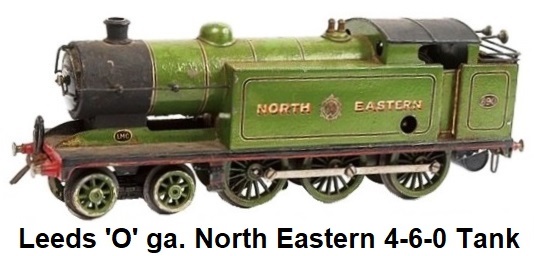
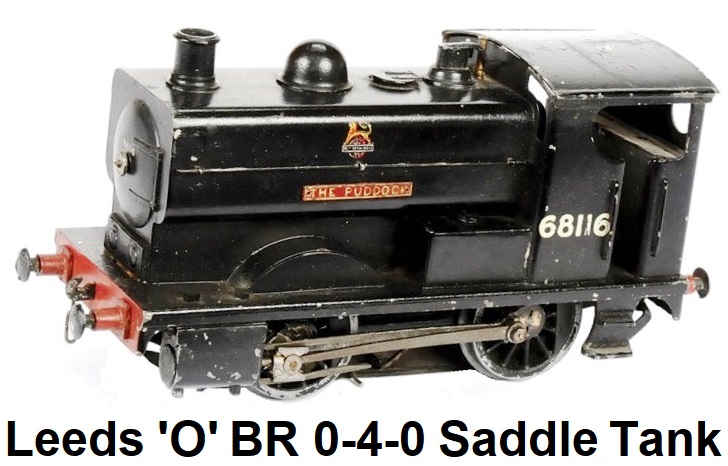

Sources for this article include:
Dutch Hornby Railway Collectors Association - https://www.dutchhrca.nl/
The Leeds Stedman Trust - http://www.leedsstedmantrust.org/
Binns Road - http://www.binnsroad.co.uk/
